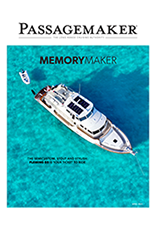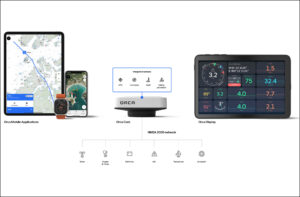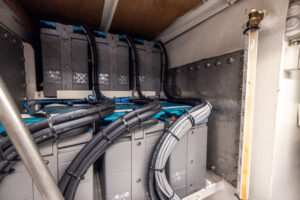
Written by Fred Khedouri for Panbo, The Marine Electronics Hub
A few days ago, just about every square inch of panel space on the main helm of my 32-foot Carolina Classic express-style sportfishing boat got covered over with the shiny black glass of two new Furuno TZTL 15F multifunction displays, the newly launched second generation of the Furuno TZ Touch series. The rest of the system includes a 12kW four-foot open array radar, a DFF1-UHD black box sonar, a smaller first-generation TZT 9 display mounted on the tower helm, and a Furuno 711C autopilot.
The new installation came about after two seasons of disappointing performance and repeated hardware failures with the electronics first installed when I had the boat built over the winter of 2012-13. The ill-starred dalliance with another electronics manufacturer had come after more than 20 years of using Furuno hardware on my fishing boats. As always, it proved amazingly easy to spend money on my boat after I made the decision to switch last October. The experienced and capable electronics guy at the boatyard where I store over the winter put together a quote for me and offered to handle the removal and sale of the existing system. The whole process took less than a week from my first inquiry to ordering the new hardware.

My boat is used almost exclusively for fishing, both onshore and offshore. The big displays allow me to run the sounder in full-screen mode to get the best coverage, while still having access to a plotter or the radar when needed. As obvious as it may sound, the key to success when fishing offshore is finding the fish. Pelagic species such as tuna are constantly on the move chasing their food supplies. Being able to see bait concentrations and schools of tuna in the water column is critical, since quite often they do not surface to feed.
When we originally placed the order in October, I specified the first generation TZT 14 displays. They were sitting in boxes just about to get installed when I saw the announcement of the TZT 2 last February (on Panbo, of course). I couldn’t resist and made a quick call to the boatyard to see if I could switch. My electronics guy was skeptical about “vaporware” that wasn’t shipping or available to try in the field. I am cursed with an early adopter mindset, however, so I told him to make the switch.
Then the wait began for Furuno’s promised “spring availability.” The new TZT 2 displays had not arrived by early May when I had my boat launched, so I had the 9″ TZT display for the tower installed at the main helm temporarily. The radar, sounder and autopilot were already in place and are fully compatible with both generations of TZT. This temporary setup gave me two months of experience with the first generation TZT as a basis for comparison to the new units once I got them. It left me deeply grateful to have two large screens again so that I could run both the plotter and the sonar or radar in full screen. Switching the single small screen back and forth was pretty tiresome.
The most obvious difference between the first and second generation units is the touch-only interface of the TZT 2, which Ben described fully in his review from the February 2015 Miami Boat Show when Furuno first announced the new product. The rotary knob on the first generation unit has its advantages, especially if you have dry fingers like mine that do not always get a response from the touch screen. However, the menu structure on the TZT 2 is “flatter” and requires less delving into submenus. Instead of using multiple submenus, Furuno has split the function menus into two separate menus, one accessed by tapping or swiping from the right side and the other (more detailed) by swiping up. For example, when the sonar is on screen, the menu on the right has the basic operating adjustments, such as frequency, gain, and range, as well as choices for setting a new waypoint or starting navigation. The menu from the bottom swipe has setup parameters, such as choosing white or blue background.
I found this arrangement to be an excellent and practical approach. It requires a small period of familiarization to avoid the “I don’t see…” problem of picking the wrong menu, but after that all the functions are immediately visible without going into any submenus. Virtually every routine operating adjustment is only one layer down, and some of the most used features are even on top at all times. For example, on the sonar screen you can tap the depth box on the lower left and switch from high frequency to low frequency without calling up a menu at all. The same is true of the transmit and standby control for the radar.
This screenshot shows the right side menu when sonar is full screen or the active window. When the plotter is active, the right side menu changes to functions related to charting and navigation. The first generation TZT does something similar, though not as cleanly, since many more functions are shown on the single TZT menu than the simple one shown on these TZT 2 screenshots, because the TZT does not have the second function menu along the bottom.

As is also evident from the sounder screenshot above, the performance is excellent. This shot is taken with the DFF1-UHD providing the sonar input, though I did experiment a little with the built-in sonar in the TZT 2. It is also quite good and probably would get the job done for many users, especially if they install a high performance transducer. That is a significant potential cost saving for many people since the external DFF1-UHD is nearly $2,000.

The screenshot above shows the plotter version of the side menu on the TZT 2. The radar overlay is turned on and astern of the boat icon; you can also see an AIS target displayed with its course vector line and a radar return just inside the green circle. AIS targets are color- coded green for Class B and blue for Class A. Note that since I have radar overlay enabled in this screenshot, the radar range and “TX” button are visible on the lower right corner, so it is possible to put the radar in standby without calling up a menu.

Another screen carried over from the TZT but executed in a more graphically pleasing and clear fashion is the “targets” list accessed from the “Home” button above.

The on-screen integration with the Furuno 711C autopilot is completely seamless with all basic functions available. It can be used to engage NAV or Auto modes, dodge, adjust a course when in auto mode, and go to standby with just a tap. I do not have a completely touch-only system however, as I installed one of the relatively inexpensive MCU002 remote controls on the starboard bulkhead adjacent to the armrest on the helm seat (as well as the 711C control head). This has a series of buttons and a joystick for panning the chart or moving the cursor. The remote plugs into the USB port and is not a network device. That means it can control only one MFD (in my system the starboard display). I don’t use it too much, though I have not made any really long trips since getting the TZT 2s. The remote can also engage and disengage the autopilot and is thus very handy for dodging lobster pots without needing to budge from the comfort of the helm seat.

Compared to earlier Furuno systems (including the first generation TZT), the instrument and engine data display is vastly more comprehensive and flexible. From my experience with the current Garmin and Simrad MFDs, I would say it may be the most customizable available today. It is possible to start with a completely blank screen and put just about anything on it in any order. Most types of data can be displayed numerically or graphically in small, medium, or large boxes. Any data PGN on the NMEA 2000 network can be put on the screen, along with some calculated values such as total fuel rate from multiple engines and real-time fuel economy. I don’t have any NMEA 2000 tank sensors on my system, but those can be displayed for multiple fuel tanks with customizable labels and water and waste tank levels as well.
The screen shot above shows my early attempt to construct an engine monitoring page. My boat has Cummins QSB Diesel engines with Vessel View displays. The engines are electronically controlled with a NMEA 2000 interface to convert the J1939 data. The TZT 2 instrument page allows me to show virtually everything at once for both engines in a single panel. I would have to cycle through six pages on the two VesselView displays to see the same information. For both engines it is possible to see RPMs, boost, oil pressure, coolant temperature, alternator voltage, each engine’s load and fuel rate and the combined fuel rate, and even the reverse gear temperature and pressure – and I still have space left over on the screen.

Unfortunately, one fuel function that Furuno did not include is the ability to have a “virtual” fuel gauge and calculate the available fuel remaining based on a starting input value. The TZT 2 can only show fuel level based on a tank sensor input. Garmin has incorporated the virtual tank level feature on most of its new MFD systems as well as on that little GMI-20 instrument you see on my helm. Given the reality of highly imprecise tank level sensors in a boat – the fuel sloshes back and forth and the level changes with running angle – with electronically controlled engines, a virtual gauge is much more useful and consistently accurate.
In the GMI-20 setup menu I input my main tank size of 280 gallons. When I add fuel, I can choose either “full” or a specific volume if I am not filling the tank all the way. Then the fuel counter is reset and shows whatever starting quantity I have specified. The GMI-20 takes the input data from the engines’ fuel rate and subtracts it from the starting value to show “fuel remaining.” I have found this to be very accurate when tested by refilling the tank. If the GMI-20 says I have burned 150 gallons since the last fill up, when I go to the fuel dock the tank will take 150 gallons plus or minus 1-2%. (Ben had similar experience with Maretron flow sensors.)
If the product development folks at Furuno are reading this, please put this feature on your software update list. It can’t be too hard to do; Garmin units have it (and maybe even the new Simrad units, though the older Simrad devices made a mess out of this with the infamous dysfunctional EP-85 fuel storage accessory which would do things like show that your tank was empty after 10 minutes). For anyone who makes long trips where fuel supplies are scarce or non-existent, having truly accurate fuel supply data is incredibly helpful. When I run 100+ miles offshore to fish at the canyons, I don’t want to rely on a bouncing fuel gauge to know that I will have enough fuel to get all the way home when coming back into big seas that slow me down and reduce fuel economy.
What TZT 2 negatives have shown up in my short trial? Probably the biggest one is that Furuno mysteriously stripped out some radar setting options that have been available on all their prior radar systems going back to the original NavNet and early stand-alone radars. There is no echo stretch or echo averaging. At first I thought I was just confused and could not find them on the menus (the first generation TZT has them). Furuno tech support confirmed that the TZT 2 does not support these two settings. The explanation was that they are done at the display and are processor intensive, and they did not want to slow down the system.

To be blunt, this is implausible given that the TZT 2 clearly has much more processing power than its “great-grandfather” NavNet 1 system of 15 years ago, which readily does echo stretch and echo averaging. My cynical guess is that a Furuno marketing genius wanted to create some differences between the first and second generation TZT to sustain their pitch that the TZT 2 is for smaller boats, while the original TZT is for boats over 30 feet. Other TZT capabilities that are missing from the TZT 2 are consistent with the “big boat” marketing, such as support for a large external-touch screen monitor and for Axis cameras. But echo averaging in particular can be quite useful in making vessel targets more visible in rough seas. Furuno should regard these as navigation safety features and enable them in a TZT 2 software update. Let the user decide if they slow the system too much – people can choose not to use them.
I don’t know whether it is my dry skin or a hardware issue, but I did find that the touch screen sometimes did not respond to my taps. It did not happen very often, and persistence, plus rubbing my fingers together, solved the problem. My crew did not experience the issue, so my statistically insignificant sample of three suggests that one-third of users may have the problem.
Another shortfall is the lack of a memory card slot on the front of the machine. I guess this is really more of a trade-off with which I can’t disagree, since the unit would have become too wide with a slot (or would have a smaller screen like the TZT 14). And it is possible to buy a Furuno accessory remote SD card reader. A cheaper solution is to just plug a memory stick into the USB port on the back of the display if you can access it easily. I bought a $12 USB port extender that installs into a ¾” hole so I could reach it without opening up the helm.
The speed and responsiveness of the TZT 2 is quite good. It boots up in about 2/3rds the time of the TZT. For panning and zooming the chart display, the redraw is essentially instantaneous, as it also is on the TZT. Sometimes it seemed that there was a slight delay in calling up menus or response to menu commands on the TZT 2. I’d term it “not enough to be annoying, but enough to be noticed.” My port display seems more prone to this than the starboard one, so it may be related to the settings, but I haven’t experimented enough to isolate a cause.
There is supposed to be a software update coming fairly soon that may address some of the issues I noted. It is also supposed to add Active Captain access and possibly implement the “My TimeZero” web-based storage of waypoints and routes (discussed at the end of this Panbo entry). That will be a great feature if you have Wi-Fi at the boat. It will be possible to do all your trip planning and waypoint management at home and have the TZT 2 synch the data without having to import it via a memory stick or SD card.
All in all, I am quite pleased with the TZT 2 so far except for the radar settings issue I noted above. I don’t appreciate having my highly capable 12kW open array “dumbed down.” The quality of the display image is great and practically photographic quality. The user interface is the simplest and best I have seen on the many iterations of Furuno hardware that I have owned over the years. A friend who has fifty years of commercial fishing experience but prides himself on near complete ignorance of modern technology tried out my TZT 2s and said, “Even I might figure out how to use this.” That’s not something I have ever heard said about Furuno MFDs before, which were more likely to generate comments such as, “It’s great once you learn how to use it.”

How about a big Panbo thanks for Fred Khedouri’s first guest entry, which is first class, I think. Fred is no longer chartering his handsome Carolina Classic, but the interesting Red Tail Fishing site is still up and let’s hope he’ll share more of his electronics experience. ~ Ben







